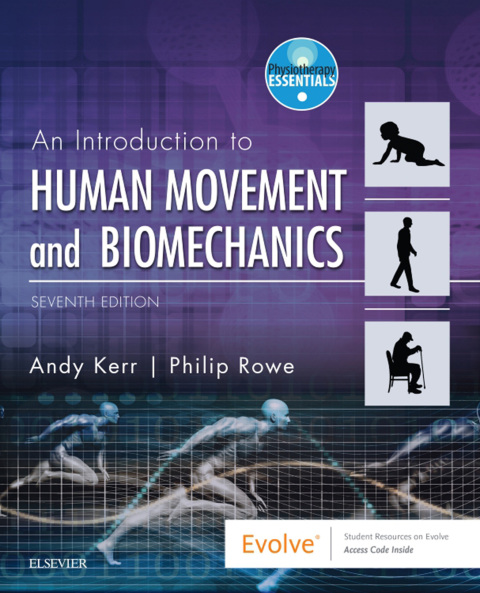Description
Efnisyfirlit
- Cover image
- Title Page
- Table of Contents
- Copyright
- Dedication
- Preface
- About the Authors
- Contributors
- Acknowledgements
- 1 Introduction
- Movement
- Understanding Movement
- Understanding Movement for Rehabilitation
- Structure of the Book
- Notice About Maths and Physics
- About the Supporting Information
- Section I How Things Move and Flow
- 2 Force
- Introduction
- What Is Force?
- What Does a Mechanical Force Do?
- Scalar or Vector?
- Drawing Vectors
- Point of Application
- Force Magnitude and Change in Motion
- What You Need to Remember so Far
- The Force of Muscles
- Magnitude of Moments
- Direction of Moments
- Analysing Force
- How Do Forces Combine?
- Analysing Muscle Force Application
- Measuring Force
- Using Mathematics to Resolve Force
- Summary Part Two
- Applying a Mobilisation Technique to the Back
- Answers to Questions Posed in the Text
- Self-Assessment: Questions
- 3 Stability and Balance
- Introduction
- Gravity: the Ultimate Force
- Centre of Mass
- Moments and Posture
- Stability
- Local and General Stability
- Standing Balance
- What You Need to Remember
- Answers to Questions Posed in the Text
- Self-Assessment: Questions
- 4 Energy and Movement
- Introduction
- Quick Revision
- Newton’s First Law (Inertia)
- Moment of Inertia
- Linear Momentum
- Rotational Momentum
- Centripetal and Centrifugal Force
- Conservation of Angular Momentum
- Newton’s Second Law: Impulse and Momentum
- Newton’s Third Law: Action and Reaction
- Summary of Newton’s Laws of Motion
- Pressure and Friction: Bodies in Contact
- Work
- Muscles at Work
- Direction of Work
- Using Machines to Do Work
- Categories of Levers
- Pulleys
- The Power of Work
- Efficiency
- Energy During Movement
- Energy Conservation
- The Determinants of Gait
- Answers to Questions Posed in Text
- Self-Assessment Questions
- References
- 5 Flow
- Introduction
- Basics of Material Science
- Connective Tissue
- Fluids and Gases
- Answers to Questions Posed in Text
- Self-Assessment Questions
- References
- Section II Human Movement
- 6 Skeletal Muscle, Muscle Work, Strength, Power and Endurance
- Introduction
- Protein Filaments
- The Sarcomere
- The Difference Between Muscle Force and Muscle Strength
- Muscle Work
- Muscle Strength
- Recruitment
- Muscle Fibre Types
- Gradation of Muscle Force
- Length-Tension Relationship
- Active and Passive Tension
- Force–Velocity Relationship
- Angle of Pull
- Stability and Sequencing
- Anatomy
- Age and Sex
- Psychological Factors
- Muscle Power
- Muscle Endurance
- Fatigue
- Measuring Muscle Work
- When Things Go Wrong
- Increasing Strength and Endurance
- Conclusion
- Self-Assessment Questions
- References
- 7 Joint Mobility
- Introduction
- Range of Movement
- Factors Involved in Assisting and Restricting Range of Movement
- Types of Therapeutic Movement of Joints
- Conclusion
- Self-Assessment Questions
- References
- 8 Posture and Balance
- Introduction
- Human Posture
- Further Reading
- Maintaining a Functional Posture
- Relevance to Practice
- Conclusion
- Self-Assessment Questions
- References
- 9 Motor Control
- Introduction
- Overview of the Motor Control System
- Theories of Motor Control
- The Damaged Motor System
- Summary
- Self-Assessment Questions
- References
- 10 Development and Decline of Movement
- Introduction
- Part One: Development of Movement
- Part Two: Decline of Movement
- Self-Assessment Questions
- References
- Section III Measurement of Movement
- 11 Nine Key Things That Define Physical Movement
- Introduction
- What Is Motion and How Do We Describe It?
- Time
- Linear Kinematics
- Angular Kinematics
- Forces and Moments
- Derived Variables
- Summary
- Self-Assessment Questions
- 12 Biomechanical Measurements Including Three-Dimensional Motion Analysis Systems
- Introduction
- Full Three-Dimensional Motion Capture
- Movement Assessment Systems
- Summary
- Self-Assessment Questions
- References
- 13 Clinical Measures of Mobility Within the International Classification of Functioning, Disability and Health Framework
- Introduction
- For further information see
- The International Classification of Functioning, Disability and Health
- Measuring Mobility Across the International Classification of Functioning, Disability and Health
- Self-Assessment Questions
- References
- 14 Physical (In)Activity
- Introduction
- Energy
- Promoting Physical Activity to Improve Health
- Moderate to Vigorous Physical Activity
- Walking and Metabolic Activities
- Is Sedentary Behaviour Bad for Us?
- How DO We Measure the Energy Expenditure of Physical Activity?
- Physical Activity in Free Living
- Objectively Measuring Free Living Physical Activity
- Importance of Walking in Physical Activity
- Changing Physical (In)Activity Behaviour
- Summary
- Answers to Questions Posed in Text
- Self-Assessment Questions
- References
- Section IV Restoring and Optimising Human Movement
- 15 Motor Relearning Principles
- Principles of Motor Learning
- Theories of Skill Learning
- Mental Practice
- Feedback
- Guidance Hypothesis
- Attentional Focus
- Self-Assessment Questions
- References
- 16 Ergonomics
- Introduction
- What Is the Environment?
- Why Do We Need to Consider the Environment?
- A Systematic Approach
- The Environment’s Impact on Movement Systems
- The Balance Theory Model
- Summary
- Self-Assessment Questions
- References
- 17 Case Studies in Human Movement
- Introduction
- Case Study One: Gait of a Child With Cerebral Palsy Before and After Corrective Surgery*
- Case Study Two: Spinal Biomechanics Case Study—Spinal Responses During Walking and Low Back Pain*
- Case Study Three: Using an Ankle-Foot Orthosis to Correct Hemiplegic Gait in Stroke Patients*
- Case Study Four: the Sit-to-Stand Movement*
- Case Study Five: Upper Limb Impairment After Stroke*
- Case Study Six: The Rowing Stroke*
- Self-Assessment Questions
- References
- Appendix
- Index






Reviews
There are no reviews yet.